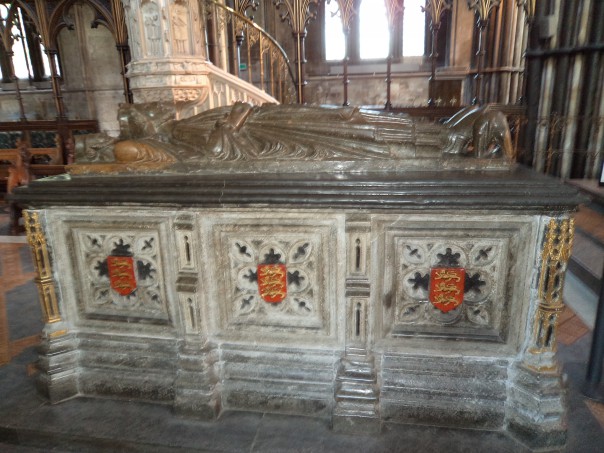This week I decided to wait until after I had heard Stuart Palmer at the AGM of the Canterbury Historical and Archaeological Society [CHAS] because I knew he would be talking about his doctoral thesis. Having received a grant from CHAS last year, he has been to a number of out-of-county archives including The National Archives at Kew and Corpus Christi College, Cambridge. Stuart is working on late medieval/early Tudor Canterbury looking at the relationship between the civic authorities and the king and for his short presentation today he focused on the 1530s.
King John’s effigy at Worcester Cathedral
As he said, this is an extremely important period, as anyone who watched Wolf Hall recently on TV will know, and from his findings he believes that there was no strong polarisation within the city’s elite on religious grounds. This is interesting because it rather goes against the idea of factional in-fighting that Peter Clark believed was the case in his book on Kent society in the early modern period. Instead Stuart sees a town government that was carefully watching what was happening at the royal court and which sought to ‘muddle through’ as best it could, not least because Henry VIII had granted Canterbury additional privileges in 1514 and the civic authorities did not want to jeopardise the city’s favoured position.
Such civic watchfulness may also have resulted from the rather uncomfortable proximity of Elizabeth Barton at St Sepulchre’s nunnery, her downfall brought about primarily by her prophesies against Henry and Anne Boleyn that would result in her execution. Moreover, also in 1534, Thomas Cromwell was to a degree active in Canterbury through Sir Christopher Hales, who was establishing himself at Hackington just to the north of the city.
Adding to this complex mix was Archbishop Cranmer and, following the Dissolution and the destruction of Becket’s shrine, at least two performances of John Bale’s rabidly anti-Catholic play ‘King Johan’, one at Hackington, probably in the archdeacon’s residence, and the other at Cranmer’s residence at neighbouring Ford.
Although all of this is extremely interesting, the idea I want to take from it is the relationship between province and court (periphery and centre) that continues to resonate today between local and central government. Not that I want to use this as a political platform but rather that in the run-up to a general election, especially in a year when Magna Carta is being celebrated (see the Centre’s own conference on the topic in June – details on this website), just how democracy does or does not function and politicians of various hues court local constituencies becomes particularly fascinating.
Of course in an age when TV debates, twitter and Facebook, not to mention blogging, become the name of the game, the idea of using a play, and an exceedingly long one at that, becomes far less appealing. Nevertheless, the reasoning is the same – the desire to get across the ‘right’ message that will bring in votes or persuade those watching/listening that the government/the nation’s soul is in safe hands. Sadly not that ‘King Johan’ is ever performed these days as far as I know, but if you have the chance to read it, it offers a valuable insight into this pivotal decade in the history of Canterbury and of England. For while I am primarily a medievalist, these decades in the first half of the sixteenth century are truly fascinating in the way different social groups ‘negotiated the political’.
 Centre for Kent History and Heritage
Centre for Kent History and Heritage Sheila Sweetinburgh
Sheila Sweetinburgh 705
705


